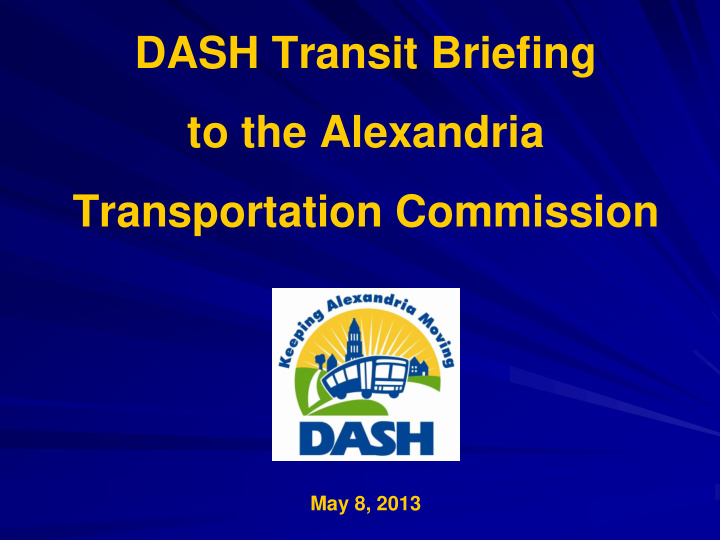



DASH Transit Briefing to the Alexandria Transportation Commission May 8, 2013
Alexandria Transit Company History 1981 - 1982 - Feasibility Study 1983 - Evaluated and modified study recommendations, developed detailed local bus plan, prepared bus procurement specifications, and determined organizational placement of bus system March 11, 1984 - System implemented with 17 buses operating on 4 routes
ATC Organizational Structure ATC Board of Directors elected annually by the Alexandria City Council acting in its capacity of sole stockholders to the Corporation The Board of Directors approves an annual Transit Development Program and budget, fare and fiscal policies, route structure and service levels The General Manager, Sandy Modell, is the chief executive and operating officer of the company and the principal staff advisor to the Board on transit matters Transit Management of Alexandria (TMA) is the subsidiary corporation owned by First Transit, which employs the operations, maintenance, and administration staff Management company, First Transit, Inc., manages TMA and the overall system, under policy direction of the Board of Directors Organizational structure similar to three systems in Virginia and about 50 nationally.
Benefits of ATC Structure City Council is not burdened with day-to-day operational issues or oversight of the transit system The transit system can leverage the City’s assets as needed, while operating as a business Employees of the transit system are assured long- term stability and competitive compensation package Additional transit-specific expertise and resources are readily available through the management company
Alexandria Transit Company Organizational Chart ATC Stockholders (City Council) ATC Board of Directors First Transit, Inc. Management Services (GM & AGM) Transit Management of Alexandria Subsidiary of First Transit Employer for Transit System Employees Old Town Transit Shop
Transit Management of Alexandria Organizational Chart Transit Management of Alexandria Subsidiary of First Transit Transportation Maintenance Administration Human Resources Bus Operators Director of Maintenance Finance Training Division Mechanics Payroll, A/P/AR Road Supervisors/Dispatchers Parts Department Procurement Safety and Loss Control Service Workers Planning & Development Charter Services Bus Cleaners Marketing Customer Service Information Technology Old Town Transit Shop
DASH System Goals Designed to support specific community objectives Safe, reliable, convenient, comfortable, and courteous Efficient in the use of resources, whatever their source
DASH Key Operating Statistics 1985 2000 2012 923,405 2,521,925 3,854,945 Ridership 17 47 72 Buses 522,705 1,194,507 1,618,986 Miles Operated 1.8 2.3 2.6 Passengers/mile 24.6 30.3 30.5 Passengers/hour
DASH Annual Ridership 4,000,000 3,500,000 3,000,000 2,500,000 2,000,000 1,500,000 1,000,000 500,000 0 1996 2000 2002 2004 2006 2008 2010 2012
Present Challenges Increased travel times and traffic congestion which negatively impact on-time service reliability Making transit attractive to choice riders by increasing convenience, safety, service, and reliability of transit Attracting and retaining qualified employees Rising fuel costs impact total operating expenses
Recommend
More recommend